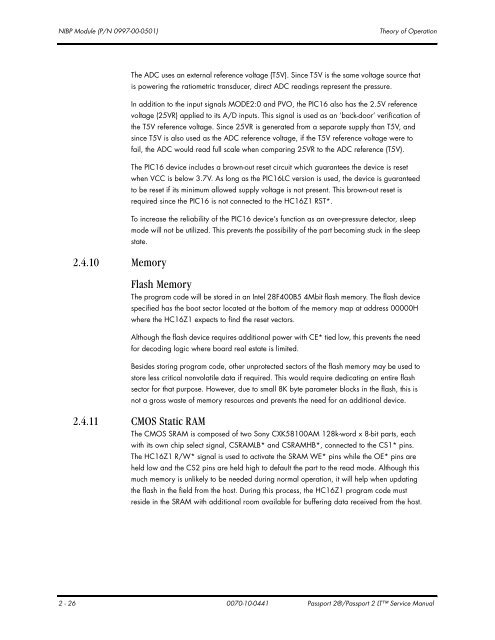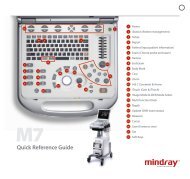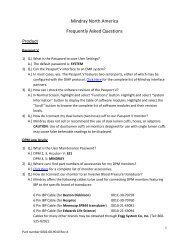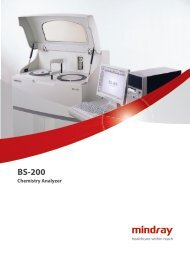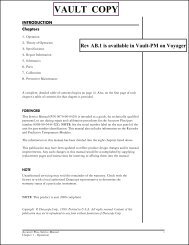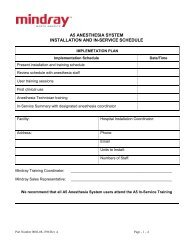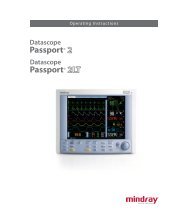Datascope Passport - Mindray
Datascope Passport - Mindray
Datascope Passport - Mindray
Create successful ePaper yourself
Turn your PDF publications into a flip-book with our unique Google optimized e-Paper software.
NIBP Module (P/N 0997-00-0501) Theory of Operation<br />
2.4.10 Memory<br />
The ADC uses an external reference voltage (T5V). Since T5V is the same voltage source that<br />
is powering the ratiometric transducer, direct ADC readings represent the pressure.<br />
In addition to the input signals MODE2:0 and PVO, the PIC16 also has the 2.5V reference<br />
voltage (25VR) applied to its A/D inputs. This signal is used as an ‘back-door’ verification of<br />
the T5V reference voltage. Since 25VR is generated from a separate supply than T5V, and<br />
since T5V is also used as the ADC reference voltage, if the T5V reference voltage were to<br />
fail, the ADC would read full scale when comparing 25VR to the ADC reference (T5V).<br />
The PIC16 device includes a brown-out reset circuit which guarantees the device is reset<br />
when VCC is below 3.7V. As long as the PIC16LC version is used, the device is guaranteed<br />
to be reset if its minimum allowed supply voltage is not present. This brown-out reset is<br />
required since the PIC16 is not connected to the HC16Z1 RST*.<br />
To increase the reliability of the PIC16 device’s function as an over-pressure detector, sleep<br />
mode will not be utilized. This prevents the possibility of the part becoming stuck in the sleep<br />
state.<br />
Flash Memory<br />
The program code will be stored in an Intel 28F400B5 4Mbit flash memory. The flash device<br />
specified has the boot sector located at the bottom of the memory map at address 00000H<br />
where the HC16Z1 expects to find the reset vectors.<br />
Although the flash device requires additional power with CE* tied low, this prevents the need<br />
for decoding logic where board real estate is limited.<br />
Besides storing program code, other unprotected sectors of the flash memory may be used to<br />
store less critical nonvolatile data if required. This would require dedicating an entire flash<br />
sector for that purpose. However, due to small 8K byte parameter blocks in the flash, this is<br />
not a gross waste of memory resources and prevents the need for an additional device.<br />
2.4.11 CMOS Static RAM<br />
The CMOS SRAM is composed of two Sony CXK58100AM 128k-word x 8-bit parts, each<br />
with its own chip select signal, CSRAMLB* and CSRAMHB*, connected to the CS1* pins.<br />
The HC16Z1 R/W* signal is used to activate the SRAM WE* pins while the OE* pins are<br />
held low and the CS2 pins are held high to default the part to the read mode. Although this<br />
much memory is unlikely to be needed during normal operation, it will help when updating<br />
the flash in the field from the host. During this process, the HC16Z1 program code must<br />
reside in the SRAM with additional room available for buffering data received from the host.<br />
2 - 26 0070-10-0441 <strong>Passport</strong> 2®/<strong>Passport</strong> 2 LT Service Manual


